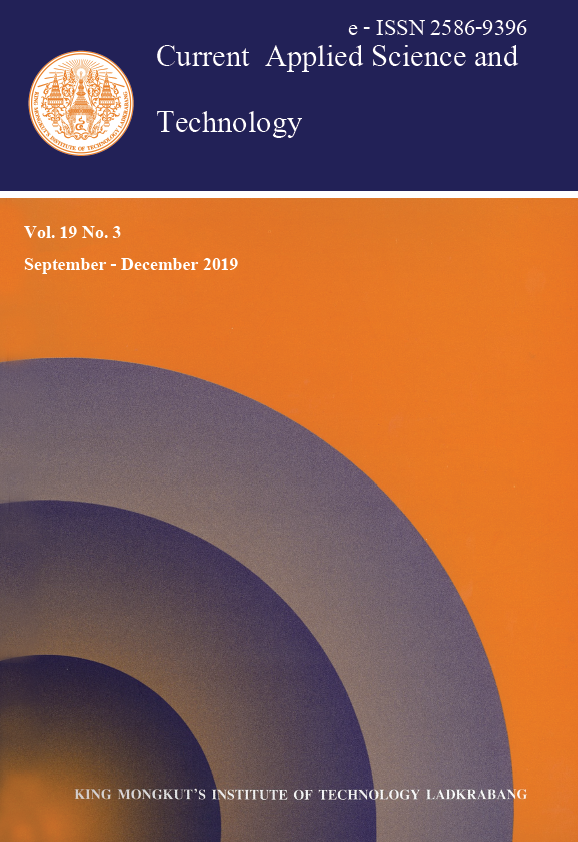Responses of Landrace Rice to Organic Fertilizer for Physiological Traits, Grain Yield and Total Phenolic Content
Main Article Content
Abstract
Organic fertilizers are used as a main source of plant nutrients in organic food production. A better understanding on the responses for the physiological traits of rice to the application of organic fertilizers is essential for organic rice production. The aim of this study was to determine the effect of organic fertilizer on physiological traits, yield components and total phenolic content of two landrace rice varieties, i.e Leam Phu and Hom Dong. A 2×3 factorial experiment in randomized complete block design with three replications was undertaken under field condition during July 2018 to December 2018. Two rice varieties were assigned as factor A and three fertilizers were assigned as factor B. Data were collected for crop growth rate (CGR) at tillering to panicle initiation stage. Leaf area index (LAI) was collected at 60, 90 and 120 days after transplanting (DAT). Agronomic traits including number of tiller per plant, plant height, number of panicle per plant, one thousand seed weight, grain yield and total phenolic content were collected at appropriate times. Fertilizers showed significantly different effect on CGR and LAI. Although chemical fertilizer gave the highest grain yield (2,572.6 kg/ha), it was not significantly higher than organic fertilizer (2,100 kg/ha). Leam Phu gave higher total phenolic content than Hom Dong at all fertilizers applied without significant difference.
Keywords: fertilizer types; crop growth rate; polyphenol; yield components
*Corresponding author: E-mail: chorkaew.an@kmitl.ac.th
Article Details
Copyright Transfer Statement
The copyright of this article is transferred to Current Applied Science and Technology journal with effect if and when the article is accepted for publication. The copyright transfer covers the exclusive right to reproduce and distribute the article, including reprints, translations, photographic reproductions, electronic form (offline, online) or any other reproductions of similar nature.
The author warrants that this contribution is original and that he/she has full power to make this grant. The author signs for and accepts responsibility for releasing this material on behalf of any and all co-authors.
Here is the link for download: Copyright transfer form.pdf
References
Isaac, R.S.R., Nair, A.S., Varghese, E. and Chavali, M., 2012. Phytochemical, antioxidant and nutrient analysis of medicinal rice (Oryza Sativa L.) varieties found in South India. Advanced Science Letters, 5, 1-5.
Chen, C.Y.O. and Blumberg, J.B., 2008. Phytochemical composition of nuts. Asia Pacific Journal of Clinical Nutrition, 17, 329-332.
Hossain, M. and Singh, V.P., 2000. Fertilizer use in Asian agriculture: implications for sustaining food security and the environment. Nutrient Cycling in Agroecosystems, 57, 155-169.
Ghosh, B.C. and Bhat, R., 1998. Environmental hazards of nitrogen loading in wetland rice fields. Environmental Pollution, 102, 123-126.
Moreno-Reséndez, A., Parcero-Solano, R., Reyes-Carrillo, J. L., Salas-Pérez, L., Moncayo-Luján, M. R., Ramírez-Aragón, M.G. and Rodríguez-Dimas, N., 2016. Organic manures improved the phenolic content, antioxidant capacity and soluble solids in pepper. Food and Nutrition Sciences, 7, 1401-1413.
Sereme, A., Dabire, C., Koala, M., Somda, M.K. and Traore, A.S., 2016. Influence of organic and mineral fertilizers on the antioxidants and total phenolic compounds level in tomato (solanum lycopersicum) var. mongal F1. Journal of Experimental Biology and Agricultural Sciences, 4, 414-420.
Tuaño, A.P.P., Xu, Z., Castillo, M.B., Mamaril, C.P., Manaois, R.V., Romero, M.V. and Juliano, B.O., 2011. Content of tocols, γ-oryzanol and total phenolics and grain quality of brown rice and milled rice applied with pesticides and organic and inorganic nitrogen fertilizer. Philippine Agricultural Scientist, 94, 211-216.
Kesarwani, A., Chiang, P. and Chen, S., 2017. Distribution of phenolic compounds and antioxidative activities of rice kernel and their relationships with agronomic practice. The Scientific World Journal, 61, 1-6.
Torres, A.M., Mau-Lastovicka, T. and Rezaaiyan, R., 1987. Total phenolics and high-performance liquid chromatography of phenolic acids of avocado. Journal of Agricultural and Food Chemistry, 35, 921-925.
Analytical Software., 2003. Statistix8: Analytical Software User’s Manual. Tallahassee, Florida. USA.
Gomez, K.A. and Gomez, A.A., 1984. Statistical Procedures for Agricultural Research. 2nd ed. New York: John Wiley & Sons.
Reddy, T.Y. and Reddi, G.H.S., 2002. Mineral Nutrition, Manures and Fertilizers. Principles of Agronomy. 3rd ed. Ludhiana: Kalyani. pp. 204-256.
Hasanuzzaman, M., Ahamed, K.U., Nahar, K. and Akhter, N., 2010. Plant growth pattern, tiller dynamics and dry matter accumulation of wetland rice (Oryza sativa L.) as influenced by application of different manures. Nature and Science, 8, 1-10.
Ko, K.M.M., Hirai, Y., Zamora, O.B. and Guzman, L.E., 2017. Agronomic and physiological response of rice (Oryza sativa L.) under different water management system, fertilizer types and seedling age. American Journal of Planr Science, 8, 3338-3349.
Kumar, G.S., Reddy, S.N. and Ikramullah, M., 1995. Effect of seedling age and nitrogen level on performance of rice (Oryza sativa L.) under late planting. Indian Journal of Agricultural Science, 65, 354-355.
Sudarsono, W.A., Melati, M. and Aziz, S.A., 2014. Growth and yield of organic rice with cow manure application in the first cropping season. Agrivita, 36, 19-26.
Frias-Moreno, M.N., Olivas-Orozco, G.I., Gonzalez-Aguilar, G.A., Benitez-Enriquez, Y.E., Paredes-Alonso, A., Jacobo-Cuellar, J.L., Salas-Salazar, N.A., Ojeda-Barrios, D.L. and Parra-Quezad, R.A., 2019. Yield, quality and phytochemicals of organic and conventional raspberry cultivated in Chihuahua, Mexico. Notulae Botanicae Horti Agrobotanici, 47, 522-530.
Muntana, N. and Prasong, S., 2010. Study on total phenolic contents and their antioxidant activities of Thai white, red and black rice bran extracts. Pakistan Journal of Biological Sciences, 13, 170-174.


